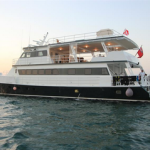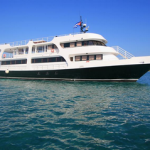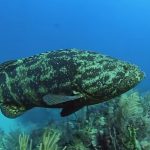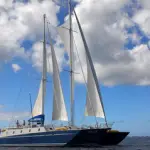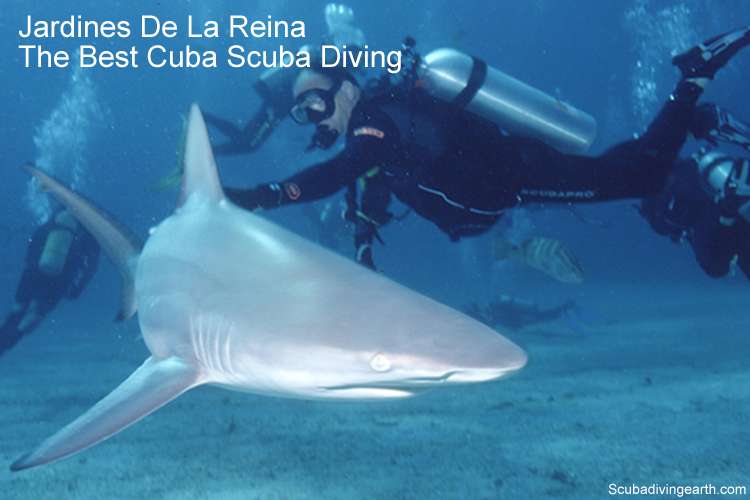
Jardines De La Reina by liveaboard includes some of the best scuba diving in Cuba
Scuba dive Jardines De La Reina by liveaboard to encounter sharks and crocodiles in the same place. This area of Cuba includes the worlds third largest reef and a near guarantee of shark sightings. It’s a pristine coral garden, which has been a protected marine park since 1996.
Jardines De La Reina liveaboards
- Halcon liveaboard.
- Tortuga liveaboard.
- Avalon I liveaboard.
- Avalon II liveaboard.
- Jardines Avalon Fleet 2.
The best way to dive Cuba is by a scuba diving liveaboard. You can check the latest and best deals on Cuba liveaboards using the following window:
For a detailed description on these Jardines De La Reina liveaboards please continue reading.
Jardines de la Reina National Park is Cuba’s second largest archipelago. Situated along the southern coast of mainland Cuba, it’s a protected marine park. The only way to scuba dive this top dive destination is by liveaboard. An almost guarantee to see reef and silky sharks and the area has many giant and Goliath groupers to enjoy.
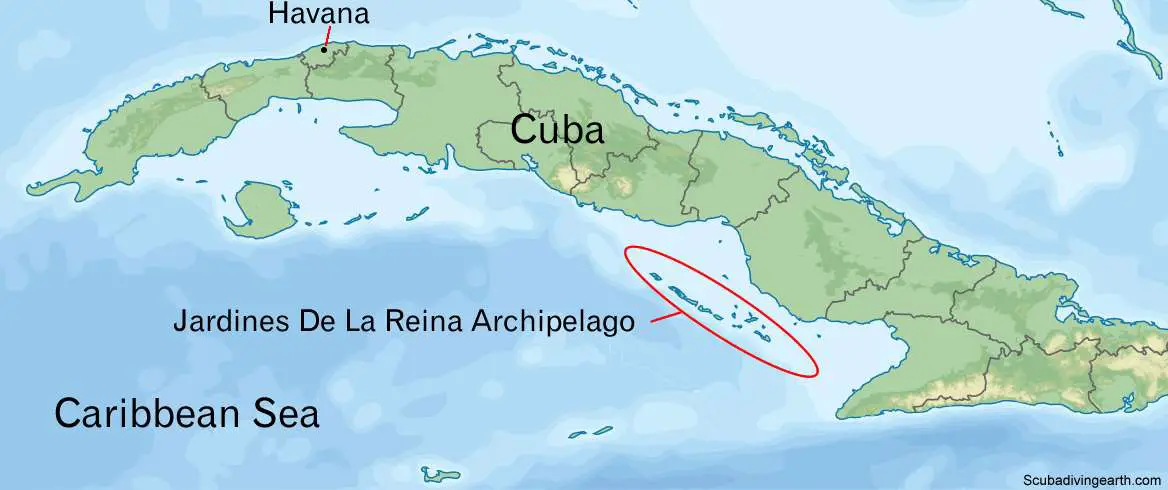
Where is Jardines de la Reina National Park
Jardines de la Reina, which translated into English as ‘Gardens of the Queen,’ is Cuba’s second largest archipelago. It is situated in the southern part of Cuba in the Caribbean sea, about 80 kilometres (50 miles) off Cuba’s coast.
Originally named by Christopher Columbus to honour the queen of Spain, it has an area of 2,170 square kilometres (840 square miles).
Jardines de la Reina islands
The archipelago is made up of over 600 cays and islands and is about 160 kilometres (100 miles) off the coast of America.
The furthest east island or cay is Cayo Breton and the furthest west is Cays Mordazo. The distance between these two points is around 150 kilometres (93 miles).
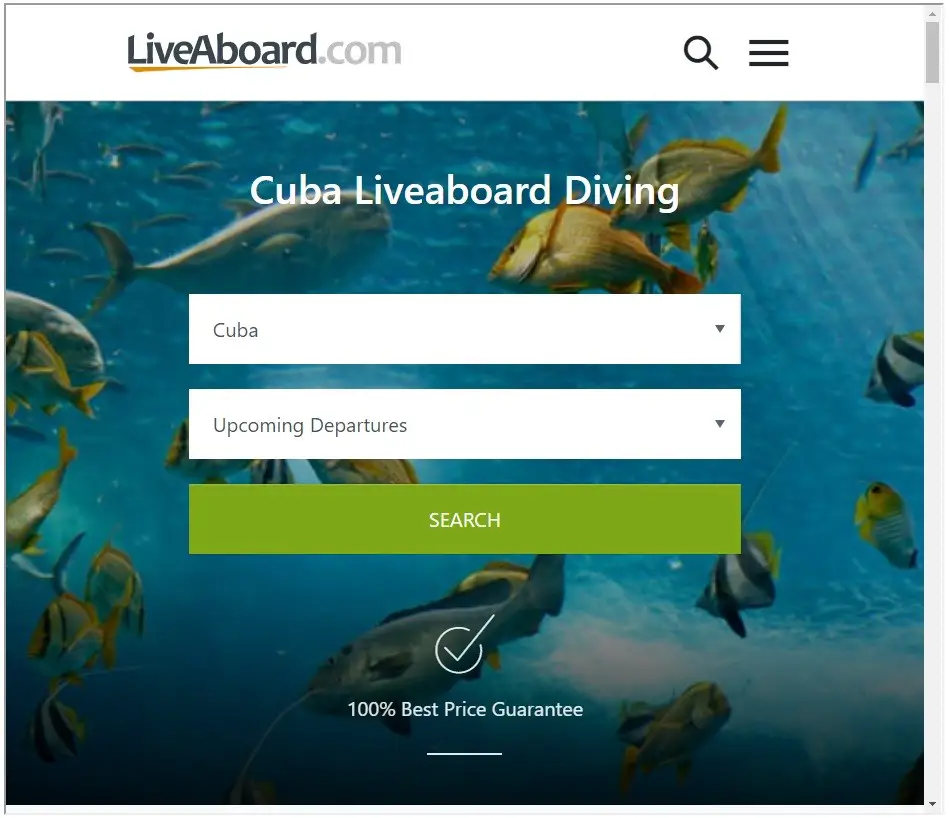
Jardines de la Reina is under threat
The threat to the eco system and marine park is from encroaching fishermen. In the past it was Fidel Castro’s favourite place to fish. Which was partly how the area came to become a protect marine park. Now the only fishing permitted is for the spiny lobster.
But with a concerted effort by the Cuban Government, the area is benefiting from it’s protected status.
But the other concern is the increase in popularity of Cuba with the acceptance of closer relations between the United States and Cuba under President Obama’s time in office. As Cuba has opened its doors to investment and for the building of hotels and more tourism, there’s concern over the future of the Jardines De La Reina National Park.
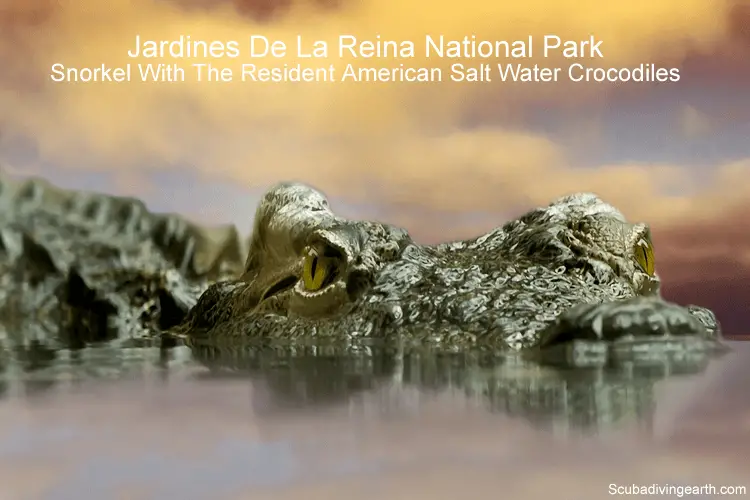
Jardines De La Reina National Park
Global Conservation is currently raising funds to implement the first Marine Protected Areas (MPA) Protection system in Cuba at Jardines de la Reina National Park or marine park. But prior to this, and after significant research by the World Wildlife Federation, the area was declared a protected national park in 1996. Here’s more information from the Marine Conservation Institute.
Jardines de la Reina National Park, often referred to as Galapagos of the Caribbean, is a world treasure.
Jardines de la Reina National Park is one of the last major intact marine protected areas in the Caribbean. This is a Cuban refuge for critically endangered sharks, large groupers and three species of sea turtles.
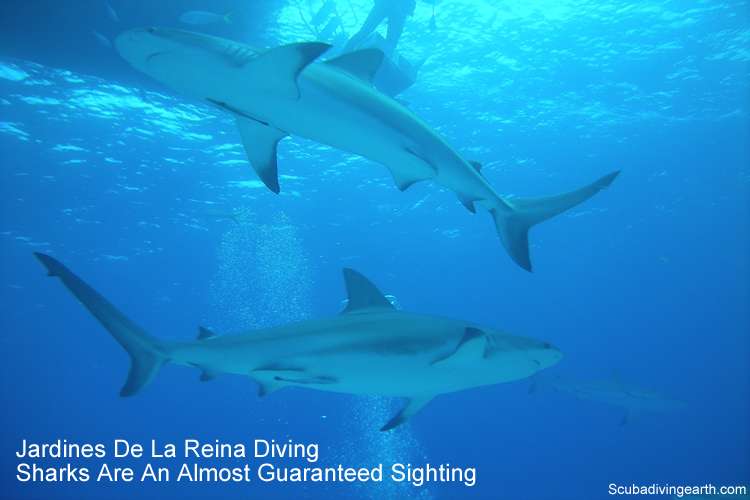
Jardines De La Reina diving
The best scuba diving that Cuba has is the area known as Jardines de la Reina. This chain of 600 islands runs along the west coast of mainland Cuba.
Jardines De La Reina is one of the most popular scuba diving destinations of Cuba and is home to a number of world-class dive sites. It is also Cuba’s top liveaboard safari destination.
Talking about a “top liveaboard safari destinations”, you may like to read this article about Red Sea diving safaris too. The Red Sea has some of the best dive sites in the world, and yet the diving is still relatively cheap.
The diving includes underwater pinnacles, caves and canyons. If you’re keen on scuba diving with sharks, Jardines De La Reina Cuba should be on your list of destinations. But scuba diving there is limited due to its protected status.
Jardines De La Reina liveaboard
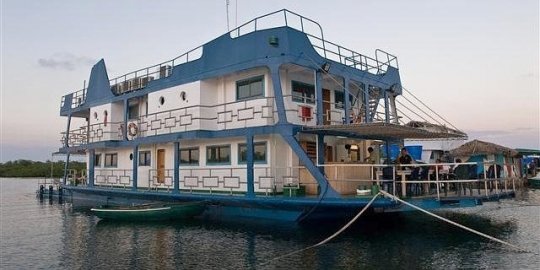
The only way to enjoy Jardines De La Reina diving is by liveaboard. The liveaboard dive boats depart from Juraco Port in the Ciego de Ávila province of Cuba. There’s a complimentary bus transfer to Port Juraco from Havana on Cuba’s mainland in the north.
The boat ride from Juraco Port to Jardines De La Reina can take between two and a half and five hours. The time it takes is dependent on the weather conditions and sea state.
There’s actually only one company that operates liveaboard boats to Jardines De La Reina National Park. They operate three ‘moving‘ liveaboard boats and one floating house boat or ‘floating sea hotel’ (see below).
Jardines De La Reina dive sites
No matter which liveaboard you scuba dive with, they all dive the same dive sites. These dive sites include Anclitas, Pipin, Mariflores, Boca de Piedras, Farallon, La Cabeza del Coral Negro, Tunel Azul, El Hueco del Pulpo, La Cueva de Carmen, Las Cruces, Vicente and Puente Escondido.
Here’s a great review of a Jardines De La Reina liveaboard on Avalon II (see below) on TripAdvisor. Like the people in this review, when you book your Jardines De La Reina liveaboard, I suggest you enjoy at least one-two days in Havana either at the start of your holiday or at the end.
The highlight for the TripAdvisor reviewers is the ‘practically untouched reefs and impressively abundant fish life, including plenty of sharks (mostly reef and silky).‘
Unfortunately, night diving is not permitted in Jardines De La Reina National Park. That means you do all your dives during the day time.
Certification level to scuba dive Jardines De La Reina
Diving at Jardines De La Reina is easy diving. There’s virtually no currents there, the waters are warm and there’s fantastic blue water visibility of up to 30 metres (100 feet).
The easy diving at Jardines De La Reina opens the area up to beginner scuba divers, as it is as enjoyable for advanced certified scuba divers too.
Jardines De La Reina day trip
I’m sorry to disappoint you, but a Jardines De La Reina day trip is not possible. The only way to scuba dive Jardines De La Reina is by liveaboard.
Jardines De La Reina snorkeling
If you also love to snorkel, as well as scuba dive, you can enjoy snorkeling with crocodiles in the mangrove areas of the islands.
One of the celebrity crocodiles at Jardines De La Reina is El Nino, which is a fairly large American salt water crocodile. You can get quite close to this crocodile in the shallow waters around the mangroves there.
Video of Jardines De La Reina diving
Jardines de la Reina is a wonderland of sharks, giant groupers, schools of colorful fish, and one of the Caribbean’s healthiest reefs.
I thought it worth sharing a video presented by the New York Times of the Jardines De La Reina diving experience.
What marine life to expect at Jardines De La Reina
One of the beauties of scuba diving Jardines De La Reina is the abundant and protected sea life. This abundance of sea life includes many sharks. Due to the number of sharks around Jardines de la Reina National Park, you are almost guaranteed to see them there.
Marine life at Jardines de la Reina National Park includes some of the following creatures:
- Caribbean reef sharks
- Black tip reef sharks.
- Silky sharks.
- Hammerheads sharks.
- Lemon sharks.
- Nurse sharks.
- Giant, Goliath (which can weigh up to a small car!) and Nassau grouper.
- American salt water crocodiles.
- Whale sharks.
- Manta rays.
- Other rays.
- Barracuda.
- Turtles (including loggerhead, hawksbill and green).
- Numerous schooling fish, including snapper and jacks.
- Jewfish.
- Moray eels.
- Queen conch.
- Lionfish, although these are invasive species not endemic of the Caribbean sea.
The fish that I love is the Goliath Grouper. They are curious fish. The Goliath Grouper are mostly very friendly towards scuba divers. They have personalities and they are intelligent fish.
Here’s a video of the Goliath Group at the ‘Garden of the Queen:
The goliath grouper is a prehistoric fish that can grow up to be 800lbs and one that Paul Nicklen didn’t expect to connect with as much as he did in Cuba’s Gardens of the Queen. One particular grouper, a young one, made friends with Paul but had an ulterior motive. It was using the camera lights to help catch his dinner!
Jardines De La Reina Cuba hotels
If you’re looking for hotels at Jardines De La Reina you may be disappointed, unless you’re happy to be accommodated on a floating sea hotel (see below).
If you’re a scuba diver looking to book a trip to scuba dive Jardines De La Reina Cuba National Park, the other option to the ‘floating sea hotel Tortuga’ is the conventional liveaboard dive boat.
See the Jardines De La Reina liveaboard options described below.
Jardines De La Reina liveaboard options
There are four Jardines De La Reina liveaboard dive options:
- Halcon liveaboard – Low budget option.
- Tortuga liveaboard – Middle budget option.
- Avalon I liveaboard – High budget option.
- Avalon II liveaboard – High budget option.
- Jardines Avalon Fleet 2 – High budget option.
Taking a look at each one of these liveaboad options in turn:
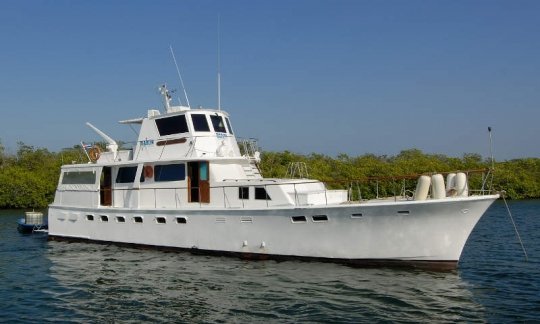
1. Halcon Jardines De La Reina liveaboard – low budget option
The Halcon is a steel mono-hulled liveaboard dive boat and a part of the Avalon fleet.
At a glance the highlights of this Jardines De La Reina liveaboard, are as follows:
- 21 metres (69 feet) mono-hulled boat.
- Maximum 12 divers.
- Run by SSI dive company.
- Internet access from sister ship the Tortuga – you need to transfer to this liveaboard by tender.
- 6 complimentary drinks per day, which includes beer, wine and cocktails.
- Air conditioned lounge area with TV, DVD and sound system entertainment.
- Dives are done from tender where your scuba equipment is prepared and waiting for you.
- 7 days trips include a total of 17 dives (but no night dives are permitted at Jardines De La Reina archipelago).
- All cabins are air conditioned, but they all share bathroom and toilet facilities.
- Food is a mixture of Cuban favourites alongside continental Italian cuisine.
To find out more or to book your Halcon liveaboard trip – Click this link to find the latest prices and discounts on a Jardines De La Reina liveaboard.

2. Tortuga Jardines De La Reina liveaboard – middle budget option
Sister ship to Halcon, Avalon I and Avalon II, this is the middle budget option to scuba dive Jardines De La Reina.
Totuga is anchored in Jardines De La Reina, which is a floating steel house boat. To get to Tortuga, you take an Avalon transfer boat from the Port of Jucaro.
At a glance the highlights of this Jardines De La Reina liveaboard, are as follows:
- 34 metres (112 feet) steel house boat.
- Maximum 25 divers.
- Run by SSI dive company.
- Internet access and WIFI.
- 6 complimentary drinks per day, which includes beer, wine and cocktails.
- Air conditioned lounge area with TV, DVD and sound system entertainment.
- Dives are done from tender.
- 7 days trips include a total of 17 dives (but no night dives are permitted at Jardines De La Reina archipelago).
- All 8 cabins are air conditioned with ensuite bathroom and toilet facilities.
- Food is a mixture of Cuban favourites alongside continental Italian cuisine.
To find out more or to book your Tortuga liveaboard trip – Click this link to find the latest prices and discounts on a Jardines De La Reina liveaboard.
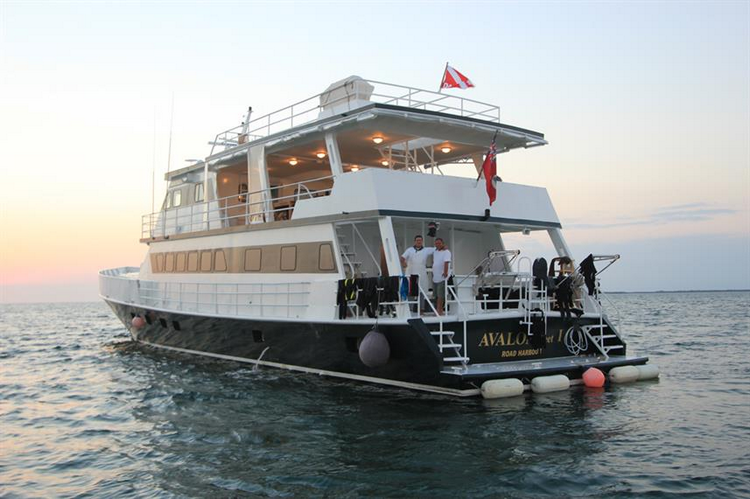
3. Avalon I Jardines De La Reina liveaboard – high budget option
The Avalon I Jardines De La Reina liveaboard dive boat is one of two higher budget options to scuba dive the Gardens of the Queen Cuba. Featuring a sundeck with a Jacuzzi, this large mono-hulled boat provides for a luxury diving experience.
At a glance the highlights of this Jardines De La Reina liveaboard, are as follows:
- 36 metres (118 feet) steel mono-hulled boat.
- Maximum 18 divers.
- Run by SSI dive company.
- Internet access from sister ship the Tortuga – you need to transfer to this liveaboard by tender.
- Complimentary sunset aperitifs, plus 6 complimentary drinks per day, which includes beer, wine and cocktails.
- Air conditioned lounge and dining area with TV, DVD and sound system entertainment.
- Dives are done from tender.
- 7 days trips include a total of 17 dives (but no night dives are permitted at Jardines De La Reina archipelago).
- All 8 cabins are air conditioned with ensuite bathroom and toilet facilities, plus TV and DVD.
- Food is a mixture of Cuban favourites alongside continental Italian cuisine.
To find out more or to book your Avalon I liveaboard trip – Click this link to find the latest prices and discounts on a Jardines De La Reina liveaboard.
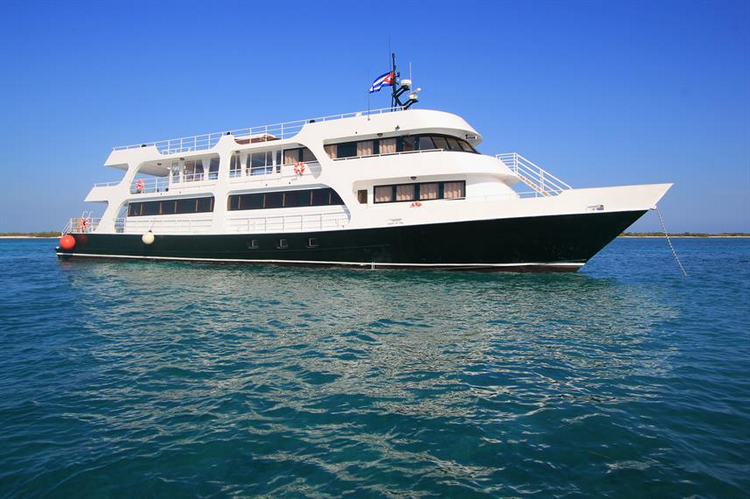
4. Avalon II Jardines De La Reina liveaboard – high budget option
The Avalon II Jardines De La Reina liveaboard dive boat is very similar to Avalon I, except it’s slightly longer in length and carries two more scuba divers.
At a glance the highlights of this Jardines De La Reina liveaboard, are as follows:
- 40 metres (132 feet) steel mono-hulled boat.
- Maximum 20 divers.
- Run by SSI dive company.
- Nitrox diving is available at an extra charge – this is the only Jardines De La Reina liveaboard dive boat with nitrox on board.
- Internet access from sister ship the Tortuga – you need to transfer to this liveaboard by tender.
- 6 complimentary drinks per day, which includes beer, wine and cocktails.
- Air conditioned salon with bar that has a TV, DVD and sound system entertainment. Plus an open-air dining area.
- Dives are done from tenders.
- 7 days trips include a total of 17 dives (but no night dives are permitted at Jardines De La Reina archipelago).
- All 8 cabins are air conditioned with ensuite bathroom and toilet facilities, plus TV and DVD.
- Food is a mixture of Cuban favourites alongside continental Italian cuisine.
To find out more or to book your Avalon II liveaboard trip – Click this link to find the latest prices and discounts on a Jardines De La Reina liveaboard.
5. Jardines Avalon Fleet 2
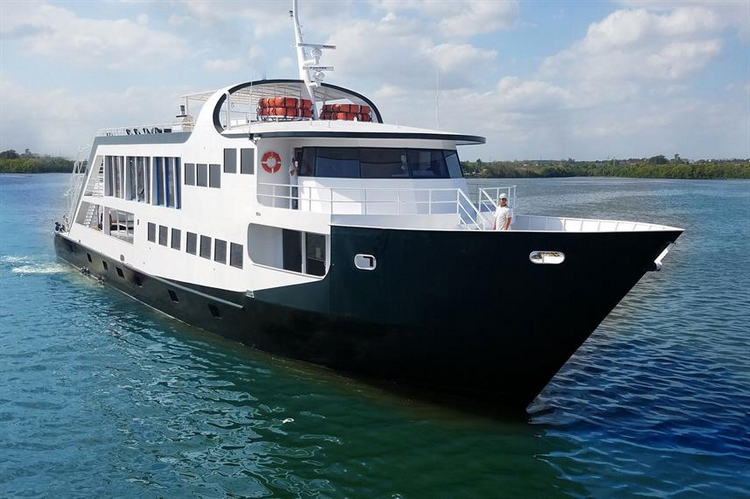
The Jardines Avalon Fleet 2 is a steel mono-hulled liveaboard dive boat and a part of the Avalon fleet.
At a glance the highlights of this Jardines De La Reina liveaboard, are as follows:
- 43 metres (140 feet) mono-hulled boat.
- Maximum 24 divers across 12 cabins.
- Free snacks, free wine with dinner and welcome cocktails.
- Air conditioned saloon with TV, DVD and sound system entertainment.
- Dives are done from tender where your scuba equipment is prepared and waiting for you.
- 7 days trips include a total of 18 dives (but no night dives are permitted at Jardines De La Reina archipelago).
- All cabins are air conditioned and have en-suite bathrooms.
- Food is a mixture of Cuban favourites with Western food and vegan or vegetarian options.
- Nitrox available.
To find out more or to book your Jardines Avalon Fleet 2 liveaboard trip – Click this link to find the latest prices and discounts on a Jardines De La Reina liveaboard.
Jardines De La Reina water temperature
The average water temperature in the Caribean seas around Jardines De La Reina are 27.5°C (81.5°F).
The lowest water temperature you’ll experience when you dive Jardines De La Reina is 26°C (79°F). With the highest water temperature peaking at around 29°C (84°F).
You are always advised to wear some form of protection, even with the warm waters of the Caribbean. I suggest to either wear a nylon protective suit or a 3mm wetsuit. However, I always dive there in my full-length 3mm wetsuit.
Best time to dive Jardines De La Reina
The warmest time to visit Jardines De La Reina Cuba is during their summer months. The summer months are between June to September.
The seas are at their calmest and at their clearest during this period. So great for your liveaboard scuba diving trip.
But watch out for hurricane season.
Hurricanes in the Caribbean, which includes Cuba, can hit at any time between 1st June to 30th November. They’ve even been known to form as early as May too. So if you want to visit between these months, be aware that your scuba diving from your liveaboard may be adversely affect too.
You certainly don’t want to be on a liveaboard when a hurricane hits. As it’s bad enough when these wind masses hit land.
I hope you enjoyed this article about Jardines De La Reina liveaboard
I’d love to hear from you. Tell us about your adventures of diving and snorkeling, in the comments below. Please also share your photos. Either from your underwater cameras or videos from your waterproof Gopro’s!
If this article hasn’t answered all of your questions. If you have more questions either about snorkeling or scuba diving (or specifically about Jardines De La Reina liveaboard), please comment below with your questions.
There will also be many more articles about scuba diving (and snorkeling) for you to read and learn about these fabulous sports.
Have fun and be safe!

